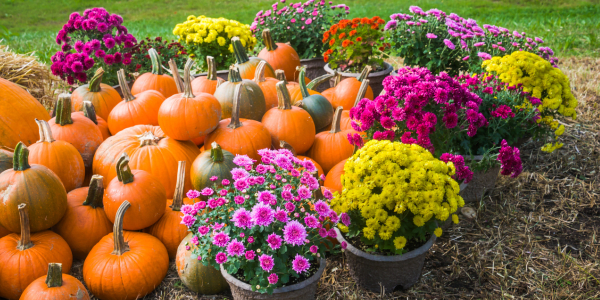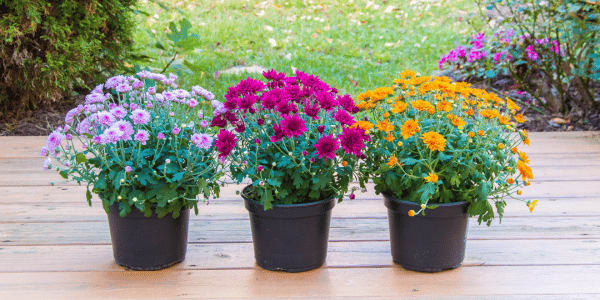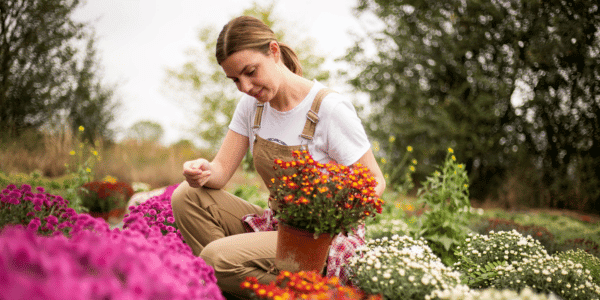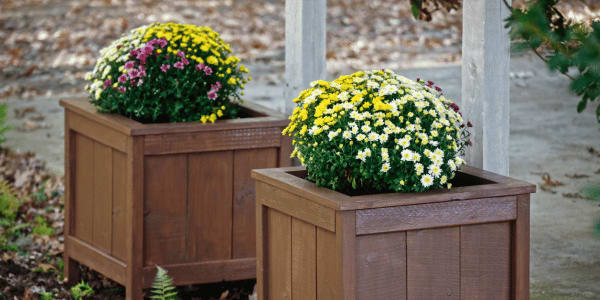How to Choose, Plant, & Care for Fall Mums

Nothing says, “Fall is here!” quite like the blooming beauty of mum flowers. An autumnal showstopper, fall mums make a statement and add vibrancy to any planter or garden. Read on to learn how to plant and care for mums so they flourish all season long!
What Are Mums?
Mums, also known as chrysanthemums, are flowers from the Asteraceae (daisy) family native to East Asia and Europe. Famous for their pom-pom-like blooms, mums come in classic fall shades like gold, burgundy, orange, deep red, and more. With their ability to thrive in August, September, and October, mum flowers have become a fall staple, adorning front porches, hanging baskets, and garden beds across the country.
Are Mums Annuals or Perennials?
Depending on the type of mum, they can be perennials or annuals. Garden mums are perennials, so they live for more than one growing season and can return year after year with the right care and winterization. Florist mums are treated as annuals, only lasting for one season.

Types of Mums
Mum flowers are divided into two categories: garden mums and florist mums.
Garden Mums
Garden mums or hardy mums are planted in garden beds or pots. They produce underground stems called stolons and have a looser, mounded look with large flowers. Garden mums are perennials, meaning they can survive cold winter temperatures in USDA zones 4 to 9 and come back each year.
Florist Mums
Florist mums or pot mums are what you usually find at the grocery store or garden center. These flowers are often “forced” to bloom in greenhouses and can’t grow in the ground and survive winters. Denser and more heavily budded than garden mums, they’re usually used in decorative pots or arrangements and discarded at the end of the season.
Planting Garden Mums
When to Plant Mums
Perennial garden mums should be planted in the spring or early fall, at least six weeks before the first frost. This gives them plenty of time to develop strong roots, make it through the winter, and revive the following year.
Where to Plant Mums
For best results, mums should be planted in an area that gets at least six hours of direct sunlight daily. Choose a dry spot with good drainage and protection from wind.
How to Care for Garden Mums
To ensure your in-ground garden mum flowers thrive season after season, you should:
- Give established mums about one inch of water weekly
- Water new mums daily
- Fertilize monthly or according to product instructions
- Add a two-inch layer of mulch to retain moisture and suppress weeds
- Prune about one inch of branch tops early in the season, then trim them every two weeks
- Remove old foliage (deadhead) after the first frost
- Winterize mums by covering with at least four inches of loose, airy mulch
RELATED: Fall Into a Beautiful Lawn: Your Autumn Landscaping Checklist
How to Choose Mums in Pots
To pick the best potted mums, look for ones with mostly closed buds and bright green leaves that aren’t wilting. Skip potted mums with soggy and waterlogged soil, a scarce appearance, or signs of damage.
How to Care for Potted Mums
To keep potted fall mums alive, you should follow proper mum care and:
- Repot them right away in a larger container
- Use a pot with drainage holes and a well-draining potting mix
- Water them until it drains out the bottom whenever the soil feels dry (likely daily)
- Make sure they get at least six hours of direct sunlight
- Remove dead blooms to encourage new growth
How Long Do Mum Plants Last?
Garden mums bloom from late summer to fall for up to eight weeks and can live for years if planted correctly. The lifespan of annual potted mums is typically six to eight weeks.

Decorating With Fall Mums
Fall mums are the crown jewel of the season. When you know how to care for mums properly, they’re sure to be a vibrant burst of color you can enjoy for weeks on end.
Looking for ways to decorate with mums? Read our article, “Fall in Love With Your Porch: 8 Whimsical Décor Ideas to Spice Up Your Autumn,” for immediate inspiration.
Mum FAQs
Do deer eat mums?
Yes, deer can eat mums. Mums’ density, bright colors, and sugar and mineral content make them an attractive meal.
Can mums come back after drying out in the fall?
Garden mums can come back after drying out with the proper care. Unfortunately, it’s rare for florist mums to come back after drying out.
When should you throw away mums?
You should throw away potted mums when they start to feel dry or the leaves or flowers are mostly brown and dull.
What happens if you don’t deadhead mums?
If you don’t deadhead and remove spent blooms, your mums may have a shorter lifespan and fewer new blooms.
Why do my potted mums keep dying?
Potted mums often die because they don’t get enough water or sunlight. Potted fall mums need at least six hours of direct sunlight daily and should be watered daily.
Can mums survive indoors?
Yes; with the right care, mums can survive indoors. However, they thrive best outside.
Why are my mums turning brown?
Mums turn brown due to dehydration, insufficient sunlight, pests, excessive watering, natural aging, or diseases.

